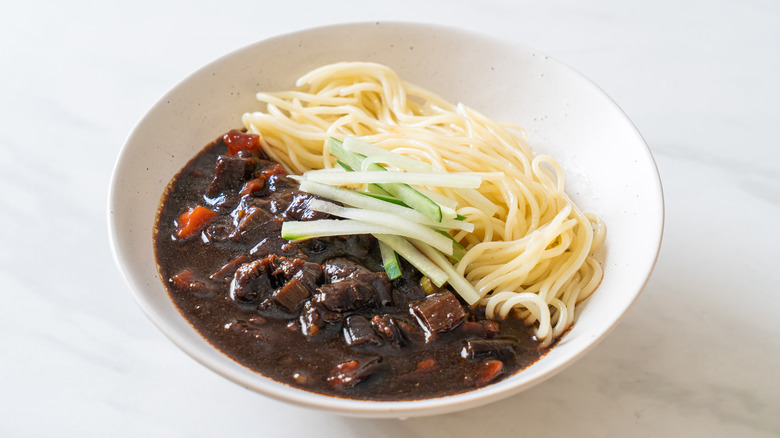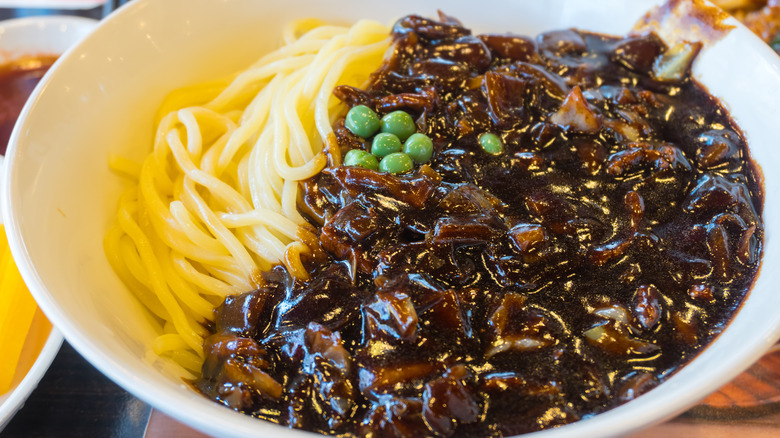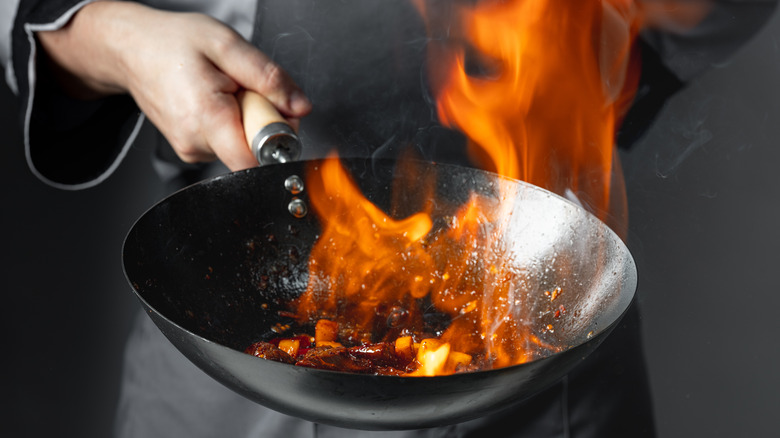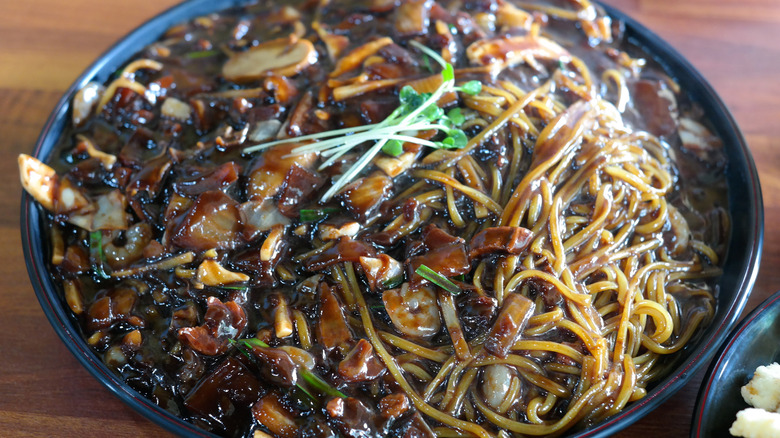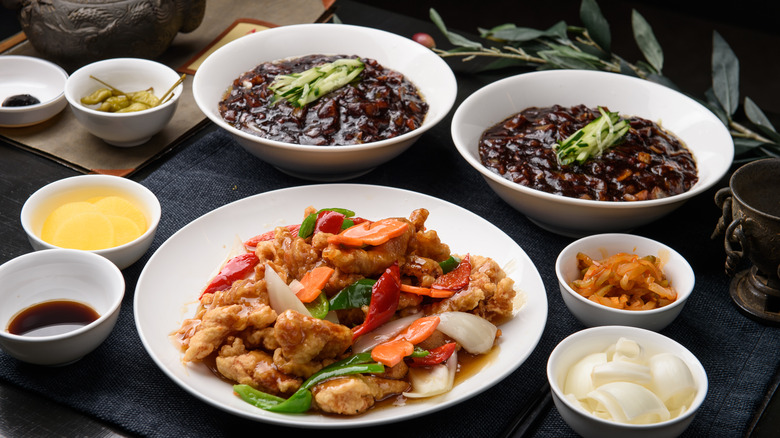Jjajangmyeon: The Korean Black Bean Noodles You Should Know
Koreans loves noodles. They have countless noodle dishes, each with their own variations from household to household, province to province, as shown in this list by Taste Atlas. Some may have heard of japchae, the traditional glass noodle dish that is served on Korean New Year (via My Korean Kitchen). Others may have a pantry full of Korean instant ramen noodles, which chef Roy Choi says deserve more credit. And then, there is jjajangmyeon, a black bean noodle dish that is a seminal part of Korean-Chinese cuisine.
Jjajangmyeon combines the words jjajang, which means black bean sauce, and myeon, which means noodles. Black bean sauce may sound strange, and perhaps muted, but it is a sweet, salty sauce with pork, vegetables, and starch (via Gastro Tour Seoul).
What is jjajangmyeon?
Jjajangmyeon is characterized by its salty, sweet sauce, chunks of stir-fried vegetables and meat, and the wok hei flavor that underlies the entire dish, according to Gastro Tour Seoul. Thanks to the thick gravy-like jjajang sauce the dish has a dark sweetness complemented by a strong fermented flavor.
The thick, chewy, hand-pulled noodles are often made fresh at restaurants. The cook grabs a hefty chunk of dough and stretches it as far as they can, and then brings the ends together, folding the dough in half, as shown in this Youtube video. This process is repeated many times over; as the noodles are folded, the layers increase, creating more strands of noodles, which get thinner with each fold. Eventually, these wheat-based noodles or myeon will be pulled until their diameter is thinner than udon but thicker than ramen, according to Curious Cuisiniere.
The noodles are drowned in the sweet, caramelized sauce, making for a hearty meal full of chopped vegetables and pork. But despite what its name implies jjajang isn't actually made from black beans.
What is jjajangmyeon made of?
Jjajang sauce starts off with a fermented wheat flour paste called chunjang. Although people may assume the paste is made with black beans, most of its composition is fermented wheat flour and a little bit of soybean, according to SPICEography. Its rich, dark brown color is actually a result of the fermentation process, per Carving a Journey. Chunjang originated from Chinese tianmian sauce or tianmianjiang, but changed over time to fit Korean tastes (via Carving a Journey). According to Just One Cookbook, tianmianjiang is still widely used in Chinese cuisine, especially in the Northern and Northeastern regions of China, and dollops of the brown sauce are commonly served with Peking duck or mantou buns.
Gastro Tour Seoul explains that the chunjang is added to a hot wok with chopped cabbage, zucchini, onion, and pork. This medley of ingredients is fried on high heat in shallow oil until they give off an intensely sweet aroma. Afterward, a slurry of potato starch and water is added to the stir fry, giving the sauce its volume. After the jjajang comes together, it is poured over a bowl of room-temperature noodles and garnished with julienned cucumber or steamed peas (via Gastro Tour Seoul).
Where is jjajangmyeon from?
Korean-Chinese cuisine isn't anything new. The history of this type of cuisine goes way back to the 19th century, when Chinese immigrants who lived in Incheon's Chinatown developed Chinese cuisine with Korean ingredients, per Asia Society.
Jjajangmyeon is a descendant of the Chinese zhajiangmian, a dish that is almost identical in pronunciation, per Korean Culture and Information Service. Zhajiangmian originated from the Shadong province of China, and it is a fried noodle dish that made a zhajiang sauce out of tianmianjiang and fried pork.
Since its introduction, this black bean noodle dish has constantly evolved, following the economic growth of Korea and the tastes of the modern man. The modern jjajangmyeon is sweeter and perhaps more decadent than its earliest form. As the port-city of Incheon grew, so did the Korean-Chinese cuisine that started there (via Korean Culture and Information Service).
What types of jajangmyeon are there?
Jjajangmyeon has loads of variations that are usually offered at Korean-Chinese restaurants. Korean chef Baek Jong-won shares in his show, "Home Cooking Teacher Baek," the many versions of this simple dish: gan jjajang, uni jjajang, and samseon jjajang (per Sports Q). According to Baek, the popular gan jjajangmyeon is a drier version of the dish. He explains that gan means dry in Chinese, so this jjajangmyeon is made with the same stir fry process but skips the addition of starchy water near the end. The pork and vegetable stir fry is thrown on a bed of noodles so that every noodle is only coated in a thin layer of meat sauce.
Baek shares the etymology of uni jjajang, which stands for ground jjajangmyeon. Ni is chopped in Chinese (via Sports Q), so as you can guess, the ingredients in the jajang sauce are finely ground. The finely ground pork and vegetables make for a thicker, saltier jjajangmyeon–-think the texture of chili. This type of jjajangmyeon is more pork forward, so it's a meat lover's dream.
Then, there is the samseon or haemul jjajangmyeon, which is seafood jjajangmyeon. Most samseon jjajang include three types of seafood: baby shrimp, squid, and mussels, per Gastro Tour Seoul. This is a more extravagant version of the cheap, quick dish, thanks to its seafood medley. Samseon jjajang has no pork in it, so it is a great pescatarian option (via Sports Q).
When is jajangmyeon eaten?
Jjajangmyeon is a delivery staple in South Korea. In fact, jjajangmyeon is what started Korea's flourishing delivery system, per Korean Culture and Information Service. Although at the outset, ordering jjajangmyeon sounds as strange as ordering spaghetti bolognese, this dish is considered a quick and easy pick-me-up that is always accessible to the common man.
This dish is eaten by Koreans year round, but it is always ordered on the days they move homes. According to Honey Tip Life, the tradition of ordering jjajangmyeon during one's moving process has nothing to do with any good mojo, but simply convenience. As the representative of all delivery food, jjajangmyeon is seen as the most convenient thing to slurp up while you unpack all of your belongings in your new apartment.
Another day jjajangmyeon is particularly sought out is April 14th or Black Day. According to E Today, Black Day is a recently invented holiday celebrating single people in Korea. In Korea and Japan, there are two days to celebrate love and relationships. Of course, there's Valentine's Day on February 14th, and one on March 14th called White Day, per Smithsonian Magazine. White Day is a day for those who received Valentine's Day gifts to give back gifts and letters to their admirers or lovers. Those who don't get anything on Valentine's Day or White Day celebrate Black Day, a day where they eat black-colored jjajangmyeon and dress in all-black attire (via Smithsonian Magazine). Although it seems to be a melodramatic holiday, Black Day is usually taken as a lighthearted day where singles grab a bowl of noodles with their friends. According to Post Magazine, single people go out together to eat these sweet, black noodles and comically "wallow in their grief."
Where you can find jjajangmyeon
Jjajangmyeon has an incredibly rich history for something that is considered a cheap take-out dish. This sweet and savory noodle dish is a must-have if you're going out for Korean-Chinese fusion. Make sure to order these noodles with some tangsuyuk, which is deep fried pork drenched in sweet and sour sauce. If there are no Korean-Chinese joints in your area, you can try making jjajangmyeon at home by purchasing a tub of chunjang at a Korean grocery store or some tianmianjiang as a substitute. Jjajangmyeon's hand-pulled noodles are hard to come by, so anything from lo mein to spaghetti can work.
If all else fails, you can find Chapagetti, an instant jjajangmyeon, in the instant noodle aisle of your local Asian grocery store. Chapagetti might be a cheap replica of the original dish, but it effectively reproduces the same deep and sweet flavor of real chunjang, and it comes together much faster, per The Takeout.
